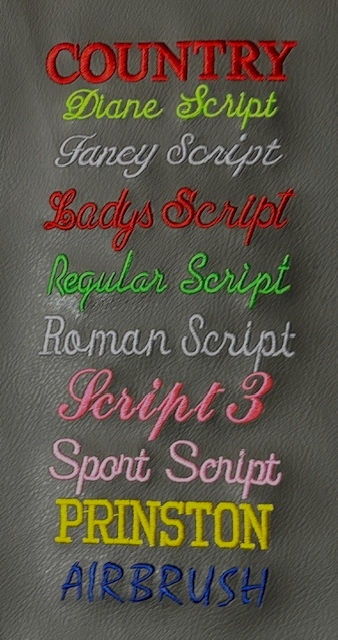Heat Transfer on T-Shirts and Aprons - Custom Designs and Logos
Heat Transfer on T-Shirts and Aprons - Custom Designs and Logos
Blog Article
The Art of Custom-made Embroidery: Opening the Keys to Creating Distinct and Memorable Styles
Needlework, a craft soaked in custom and creativity, holds within its elaborate stitches the power to change fabric into a canvas of unique expression. The tricks to producing custom embroidery styles that captivate the eye and leave a long-term impact lie in a delicate balance of strategy, imagination, and attention to detail. As we dig right into the world of custom embroidery, we discover the nuanced interplay between thread selection, stitch complexity, and style personalization that elevates a mere garment to a work of art. Join us on a trip with the art of custom-made embroidery as we decipher the enigmas behind crafting really extraordinary and unique creations.
Picking the Right Needlework Threads
When picking needlework strings, what crucial variables should you consider to make certain the ideal outcomes for your custom designs? The choice of needlework thread is important in figuring out the last outcome of your embroidered design.
Additionally, the weight or thickness of the string plays a significant duty in the look of the needlework. Thicker strings can include dimension and texture to your layout, while finer strings are excellent for detailed details and small message. Furthermore, thinking about the shade fastness and washability of the thread is essential to ensure that your custom layouts keep their quality and vibrancy gradually. By very carefully assessing these elements and choosing high-quality strings that satisfy your particular requirements, you can boost the visual appeal and long life of your stitched developments.
Checking Out Different Stitch Methods
To look into the world of 'Exploring Various Stitch Techniques', one should comprehend the complexities and subtleties that each stitching technique gives the art of embroidery. Various stitch techniques not only add aesthetic rate of interest but additionally add to the total structure and measurement of the layout. One preferred stitch technique is the satin stitch, which includes closely stuffed parallel stitches to create a smooth and shiny surface area, perfect for completing forms and developing bold describes.
On the other hand, the backstitch is a versatile method usually utilized for laying out and including fine details. It includes sewing backward to produce a strong line of needlework. In addition, the French knot stitch adds a tactile aspect to layouts, best for developing textured accents like blossom facilities or attractive touches.
Discovering different stitch methods permits embroiderers to have fun with light, darkness, and deepness within their layouts, raising the aesthetic charm and imaginative quality of their embroidery jobs. By grasping various stitching techniques, one can unlock limitless possibilities for producing special and unforgettable custom-made embroidery pieces.
Incorporating Personalized Design Elements
Having explored the ins and outs of different stitch strategies such as the company website satin stitch, backstitch, and French knot, the emphasis now changes in the direction of including personalized layout aspects in custom embroidery projects. Individualized style elements play a crucial duty in making embroidery jobs truly one-of-a-kind and unforgettable.
One more method to incorporate tailored style components is by including signs or themes that hold special significance to the recipient or mirror their rate of interests and individuality. Including a favorite blossom, animal, or hobby-related symbol can make the needlework style extra significant and tailored. Additionally, choosing colors that reverberate with the recipient or align with the designated style can additionally improve the personalization of the needlework task.
Mastering the Art of Shade Sychronisation

One secret aspect of color coordination is comprehending shade theory. This consists of recognizing just how different colors connect with each other, the feelings they share, and exactly how they can be combined to produce visually attractive designs. By using official statement color theory concepts, embroiderers can develop unified color schemes that improve the general appearance of the design.
Furthermore, taking note of contrast is critical in color sychronisation. Making use of contrasting shades can help specific aspects of the design pop, boost legibility, and create a visually vibrant needlework piece. By grasping the art of color sychronisation, embroiderers can raise their layouts and create memorable pieces that resonate with clients and visitors alike.
Enhancing Appearance With Advanced Embroidery Stitches
French knots, as an example, are best for including tiny, raised dots to your design, imitating the appearance of beads or developing a textured surface. Bullion knots, on the other hand, can be used to develop twisted, ropelike components that include a glamorous feeling to the needlework. Seed sewing involves little, scattered stitches that can fill out locations with a polychromatic appearance, while turkey job develops fluffy, dimensional accents reminiscent of animal fur or foliage. Experimenting with these advanced embroidery stitches allows you to push the boundaries of traditional needlework and develop absolutely one-of-a-kind and aesthetically attractive structures in your designs.
Verdict
To conclude, the art of custom embroidery involves a mix of picking the appropriate threads, discovering numerous stitch methods, integrating tailored design components, grasping shade sychronisation, and improving appearance with advanced stitches. By understanding and carrying out these crucial elements, embroiderers can develop distinct and unforgettable designs that display their creativity and ability. Embroidery fanatics can open the keys to creating beautiful and custom pieces that stick out and leave a long lasting perception.
Report this page